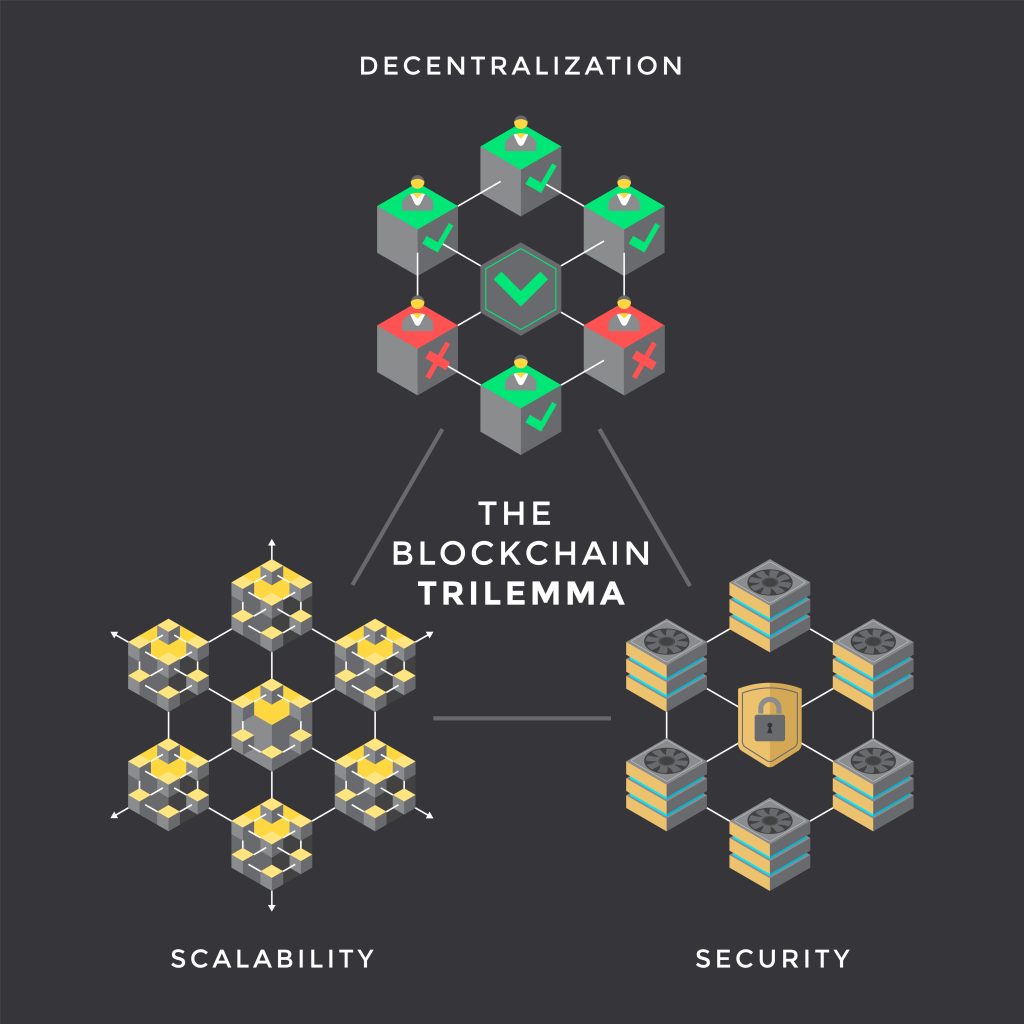In the world of blockchain technology, there’s a significant challenge known as the “blockchain trilemma” that developers grapple with daily.
Understanding the Blockchain Trilemma?
This concept, first introduced by Ethereum co-founder Vitalik Buterin, refers to the inherent trade-offs that come with building a blockchain network. In essence, the blockchain trilemma posits that it’s impossible to achieve all three desirable qualities—scalability, security, and decentralization—at the same time. Developers often find themselves having to prioritize two of these qualities, leaving the third to lag behind.
This crypto triangle has become a significant hurdle in the development of blockchain technology, as each of these three pillars plays a vital role in creating a functional and efficient network. Let’s delve into the core of this trilemma and examine each of these pillars more closely.
The Three Pillars of the Trilemma: Scalability, Security, and Decentralization
Before diving into the trilemma itself, let’s briefly discuss its three components.
Scalability
Scalability refers to a blockchain network’s ability to handle an increasing number of transactions as more users and nodes join the platform. An ideal blockchain should be able to manage high transaction volumes without sacrificing transparency or security. Unfortunately, many existing public blockchains face challenges when it comes to scalability, leading to issues like increased transaction fees and network congestion. To overcome these challenges, developers have been exploring various scaling solutions, such as sharding, sidechains, and Layer-2 technologies.
Security
The security of a blockchain network is crucial in maintaining trust among its users. Blockchain security is typically achieved through a combination of consensus mechanisms, cryptography, and decentralization. Transactions are linked to one another in a cryptographic chain, and their validation is performed in a decentralized manner using consensus algorithms like Proof of Work (PoW) or Proof of Stake (PoS). Different types of blockchains—public, private, or consortium—may employ different security protocols depending on their specific use cases.
Decentralization
Decentralization is the process of distributing control and decision-making power from a central authority to individual nodes or entities within the network. In a decentralized blockchain, every new transaction requires verification before it’s added to the chain. This distributed control ensures that no single group or individual has complete authority over the network, reducing the chances of biased decisions or malicious behavior. Decentralization also provides a robust defense against hacking attempts, as altering a single block would require tampering with all previous blocks in the chain—a near-impossible task.
Dissecting the Blockchain Trilemma
Now that we’ve established a basic understanding of the three pillars of the trilemma, it’s essential to recognize the challenges they present when combined. Achieving a perfect balance among scalability, security, and decentralization is no easy feat, and often, enhancing one aspect comes at the expense of the others.
For example, increasing the scalability of a blockchain network may involve reducing the number of nodes responsible for validating transactions, which could compromise decentralization. Similarly, focusing on security might require adopting more stringent consensus mechanisms that could hinder the network’s ability to scale efficiently.
Can the Blockchain Trilemma be Solved? Exploring Potential Solutions
While many believe that the blockchain trilemma is a permanent problem, several innovations in the decentralized ecosystem have emerged to tackle it. Some of these solutions include advanced concepts like sharding, state channels, sidechains, and Layer-1 and Layer-2 technologies.
Sharding: Divide and Conquer
Sharding is a popular solution that involves dividing the blockchain into smaller parts or shards, which are then assigned to individual validators. This approach reduces the burden on any single entity and improves the network’s overall scalability. However, sharding comes with its own set of risks, such as the potential loss of an entire shard if all validators fail.
State Channels: Off-the-Chain Transactions
State channels enable direct peer-to-peer transactions that occur off the main blockchain. By doing so, they enhance the network’s security and transaction speeds. Once a channel is closed, only the starting and ending information is sent to the main blockchain. Some well-known examples of state channels include the Raiden network by Ethereum and the Bitcoin Lightning Network.
Sidechains: Complementary Chains for Enhanced Performance
Sidechains are transactional chains that connect to the main blockchain through a two-way peg. They use separate consensus protocols to regulate their scalability and speed while the main chain handles security and dispute resolution. Sidechains can improve blockchain performance and reduce transaction times without affecting the main chain’s stability.
Layer-1 and Layer-2: Building on Top of the Foundation
Layer-1 is the implementation layer responsible for maintaining blockchain security, while Layer-2 authenticates transactions in Layer-1 and addresses network congestion issues. By optimizing the communication between these layers, developers can enhance the main blockchain’s functionality.
The Future of the Blockchain Trilemma
So, is the blockchain trilemma solved? Not entirely, but the solutions mentioned above are paving the way for a more balanced approach that addresses the challenges of scalability, security, and decentralization. As the crypto world continues to innovate, we may see even more advanced solutions that could potentially overcome the blockchain trilemma once and for all.
For now, blockchain developers have their hands full as they strive to find the right balance between the trilemma’s elements. Whether it’s through nested blockchains, sharding, or improved Layer-2 technologies, the race is on to make the blockchain more efficient, secure, and accessible for everyone.
As we keep an eye on the developments in the blockchain space, it’s essential to stay informed about the latest solutions and breakthroughs. At Coinary, we’re dedicated to helping you stay on top of the crypto world and understand the intricacies of concepts like the blockchain trilemma. So, keep exploring, learning, and staying ahead in the exciting world of blockchain technology.









